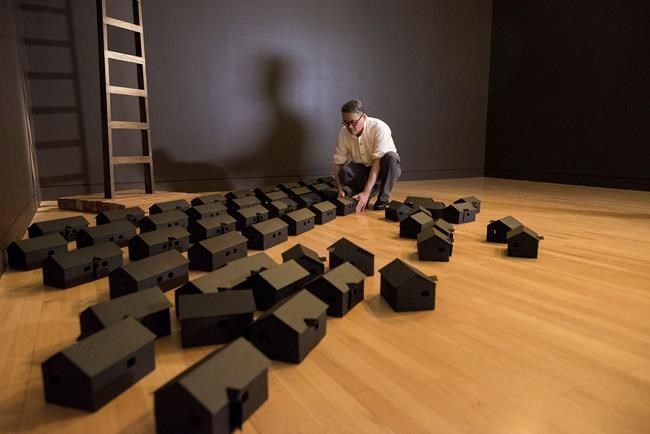
Steven Nunoda, a Calgary-based artist, prepares his "Ghostown" installation at the Royal Ontario Museum in Toronto on Tuesday, January 29, 2019. THE CANADIAN PRESS/ Tijana Martin
January 31, 2019 - 12:36 PM
TORONTO - As Steven Nunoda gazes over a sprawling complex of tarpaper shacks in the heart of downtown Toronto, he can't help but think of his parents and grandparents.
About 160 ankle-high huts have sprung up at the Royal Ontario Museum, each a small-scale replica of the rickety structures that Nunoda's relatives were forced to call home when they were swept up as part of the mass internment of Japanese Canadians during the Second World War.
The ordeal they and 22,000 others endured lies at the heart of the exhibition "Being Japanese Canadian: reflections on a broken world," which opens Saturday, featuring Nunoda's "Ghostown" alongside works by seven other artists from across Canada.
The Calgary-based artist said his painstaking recreation of the past should also shine a spotlight on the present, in which tarpaper "ghostowns" around the globe shelter new generations of refugees fleeing violence and longing to establish their own, true homes.
"I'm hoping that it's not just a piece about reliving a traumatic experience," Nunoda said as he set up the installation this week. "The whole point of remembering in this case is so that we all try to prevent it from happening and continuing to happen."
For Norman Takeuchi, an 81-year-old from Ottawa, the lived experience of displacement has shaped his dual identity as a Japanese Canadian artist.
This is manifested in Takeuchi's contribution to the exhibition, "Interior Revisited," which combines his North American abstract influences with a reproduction of Japanese woodblock printing. In the painting, brown and "angry" blue forms encroach on two vibrant geishas, looking down at the grey scene of a man in an internment camp.
As a child, Takeuchi remembers romping around the countryside with his brothers after his family left their Vancouver home in 1943 for a tiny village in British Columbia's interior. Takeuchi said they were spared from the internment camps, instead left to fend for themselves in a small farming community near Kamloops.
His parents stoically tried to maintain a sense of normalcy, Takeuchi recalled in a recent phone interview. It was only later in life that the full history of what happened came into stark relief.
Looking back, he said there were always signs he was "different." He remembers reading comic books about G.I. soldiers battling combatants with slanted eyes and bucked teeth. He realized, "We looked like the enemy." And at times, he was treated that way by the kids who pelted him and his brothers with racial taunts.
"I'd been feeling ashamed for long enough ... (that) I decided to confront this and actually put it in my artwork," said Takeuchi. "It became a great weight off my shoulders, I think, to finally come to grips with the idea of who I am."
The struggle to reconcile this sense of being "the other" with the pressure to assimilate was common for Japanese Canadians in the aftermath of internment, said Katherine Yamashita, one of the exhibition's four curators.
Yamashita, who is a member of the arts committee at the Japanese Canadian Cultural Centre, said the geographic and generational diversity of the artists being showcased is a testament to the emerging sense of Japanese Canadian identity.
The exhibition is woven throughout the ROM's Sigmund Samuel Gallery of Canada, which Yamashita said sends a message that Japanese Canadian internment is an inextricable part of the country's history, and one that painful echoes in the present day.
"I think there's another relevance that relates to acknowledging this significant history as it's being enacted on others right now," she said. "We still have a long way to grow and learn about tolerance and understanding and what it means to be a Canadian in general."
The exhibition is set to run until Aug. 5.
News from © The Canadian Press, 2019